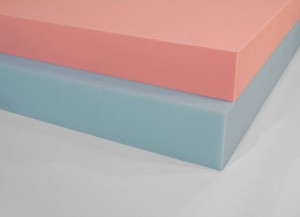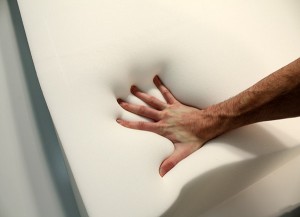If, in 2015, you haven’t heard of memory foam, you may be living (or sleeping) under a rock. The temperature-sensitive material has become synonymous with comfort and relief in the bedding industry over the last decade. But as people start to understand what makes this material so special, questions have begun to shift from “this material does WHAT?” to “how can I maximize these benefits?”
Innovation often begins to happen at this point, but with a product possessing such unique traits, what may seem like a logical way to use memory foam may actually be counterintuitive. One of the biggest questions we field at Foam Factory, Inc. has to do with the thickness of memory foam in bedding, and why we build our memory foam mattresses the way we do. Let’s take a closer look.

The most important thing to remember with memory foam is that it is intended to be used as a comfort aid. Memory foam offers support to lower-pressure areas of the body, but compared to a very firm rebond foam cushion like carpet padding, there is a big difference in what the soft, comforting memory foam provides, versus the strong, supportive rebond.
Memory foam is also more of a “fluid” material than conventional foam, partly where the term “visco-elastic foam” comes from, referring to viscosity. This means body heat will soften the material, allowing a more fluid contouring of the body as pressure is applied. A conventional foam will reach “max compression” (an unofficial term), where you stop sinking at a certain point because the foam has compressed enough to hold your weight. Memory foam can keep softening as you sink deeper into the material. Eventually, you do reach “max compression,” but it’s easy to wind up with your core sagging lower than the rest of your body. This is why most memory foam layers are not thicker than 3″ or 4″. Simply put, too much memory foam is too soft.
So why is it that so many people get a fantastic night’s sleep on memory foam, when it sounds like it would act like a brick of quicksand? This leads us to our main point – mattress layering.
Because of memory foam’s ability to soften, contour, and yield to pressure, memory foam mattresses need a non-reactive, conventional foam base layer to serve as support reinforcement for the body. These base foams are firmer than the memory foam, but still soft enough to be comfortable. Conventional bases are variable in firmness as well, so you can find one that creates a comfort combination perfect for you. This concept is applied to memory toppers, where your existing mattress offers the support of conventional foam in mattress construction. 2″, 3″, or 4″ of memory foam atop a conventional foam base is the sweet spot for a majority of people. Foam Factory, Inc. sells their three densities of memory foam mattresses with different base foam types and thicknesses to fit any budget or comfort preference.
People are sometimes skeptical of layering, thinking they’re getting shorted, or that a manufacturer is trying to save a buck. Outside of mattresses that only have an inch of memory foam or less (which is too thin to offer any real benefit), this layered build is more cost-effective and functional for a customer than a solid slab of memory foam for a couple reasons.

The first, and most important, goes hand-in-hand with the softening and support mentioned earlier. If you have a 10″ thick mattress of pure memory foam, you will sink deeper and deeper, as your center of weight warms and softens the foam. Meanwhile, your arms, legs, and head will not make much of an impression because they are lighter. You’ll lack balanced support, and may wake up with aches and pains. If you ever sank right into a sagging, old innerspring mattress, that concept is amplified with overly-thick memory foam. Splitting the mattress between a few inches of memory foam and a conventional foam base gives you the memory foam’s circulation and pressure relief, with the conventional foam’s posture support and alignment.
Secondly, a mattress of pure memory would be very expensive. This means customers save money when it’s divided into a base and topper, because of lower material costs. A 10″ mattress made of only high-quality memory would be double or triple the cost of a 10″ mattress with a conventional foam base. And, you’d be paying all that extra money for something that would be much less comfortable than the layered bed. Used in the right way, the additional cost of a memory foam layer is more than warranted when considering the benefits it offers. But if used in a way that doesn’t put those benefits to work for you, you’re paying more for less.
Memory foam is an incredibly innovative material, but because of its unique characteristics and relative youth in the comfort and support market, not everyone is fully aware of where the material excels, and where alternate options may make more sense. In the case of a memory foam mattress, combining the visco-elastic layer with a conventional foam layer gives you all the pressure-relieving and comfort benefits of memory foam, without any of the potential drawbacks.

